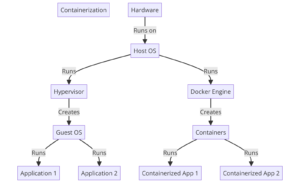Introduction
Virtualization is a foundational technology in modern IT infrastructure, allowing multiple operating systems to run on a single physical machine. At the heart of this technology lies the hypervisor, a crucial component that makes virtualization possible. This article delves into how hypervisors work, compares top hypervisor software, explores the differences between hypervisors and containerization, and provides a guide on setting up a hypervisor. We’ll also highlight the benefits of using hypervisors in virtualization.
How Hypervisors Work
What is a Hypervisor?

A hypervisor, also known as a virtual machine monitor (VMM), is a piece of software or firmware that enables the creation and management of virtual machines (VMs). It abstracts the physical hardware of a host machine, allowing multiple guest operating systems to run concurrently on a single physical host.
Types of Hypervisors
There are two main types of hypervisors:
- Type 1 (Bare-Metal) Hypervisors run directly on the host’s hardware, providing high performance and efficiency. Examples include VMware ESXi, Microsoft Hyper-V, and Xen.
- Type 2 (Hosted) Hypervisors: These hypervisors run on top of a conventional operating system, offering greater flexibility but typically lower performance than Type 1 hypervisors. Examples include VMware Workstation, Oracle VM VirtualBox, and Parallels Desktop.
How Hypervisors Function
Hypervisors work by isolating the operating systems and applications running on the VMs, ensuring they operate independently. This isolation is achieved through virtualization techniques that emulate the underlying hardware for each VM. The hypervisor allocates resources such as CPU, memory, and storage to each VM, managing the communication between the physical hardware and the virtual instances.
Best Hypervisor Software Comparison
Choosing the right hypervisor software depends on various factors, including performance, scalability, ease of use, and specific use cases. Here’s a comparison of some of the best hypervisor software available:
VMware ESXi
- Type: Type 1
- Features: Robust performance, extensive features, large ecosystem, strong support
- Use Case: Enterprise environments requiring high availability and advanced management capabilities.
Microsoft Hyper-V
- Type: Type 1
- Features: Integration with Windows Server, cost-effective, good performance, robust security features
- Use Case: Organizations using Microsoft infrastructure are looking for a cost-effective solution.
Xen
- Type: Type 1
- Features: Open-source, high performance, robust security, flexibility
- Use Case: Environments requiring customization and open-source solutions.
VMware Workstation
- Type: Type 2
- Features: Easy to use, powerful features for development and testing, good performance
- Use Case: Developers and IT professionals need a desktop virtualization solution.
Oracle VM VirtualBox
- Type: Type 2
- Features: Open-source, cross-platform, easy to use, flexible
- Use Case: Users looking for a free and versatile virtualization tool.
Hypervisor vs Containerization

Virtualization and containerization are technologies used to optimize hardware resources, but they achieve this differently.
Virtualization with Hypervisors
- Architecture: Hypervisors create and manage VMs, each with its operating system and applications.
- Overhead: Higher overhead due to running multiple operating systems.
- Isolation: Strong isolation between VMs.
- Use Case: This solution is suitable for running multiple operating systems on a single host, supporting legacy applications, and providing robust security and isolation.
Containerization
- Architecture: Containers share the host OS kernel but run isolated instances of applications.
- Overhead: Lower overhead as containers share the host OS.
- Isolation: Less isolation compared to VMs, as they share the same OS kernel.
- Use Case: Ideal for microservices architecture, continuous integration/continuous deployment (CI/CD) pipelines, and environments where resource efficiency and fast startup times are critical.
How to Set Up a Hypervisor
Setting up a hypervisor involves several steps, from hardware preparation to installation and configuration.
Hardware Preparation
- Ensure Compatibility: Verify that your hardware is compatible with the hypervisor you plan to use. Check for support for virtualization extensions like Intel VT-x or AMD-V.
- Sufficient Resources: Ensure your hardware has enough CPU, memory, and storage to support the VMs you plan to run.
Installing the Hypervisor
- Download: Obtain the hypervisor software from the official website (e.g., VMware ESXi, Microsoft Hyper-V).
- Create Boot Media: Use a tool like Rufus to create a bootable USB drive with the hypervisor installation image.
- Boot from USB: Insert the USB drive into your server and boot from it.
- Follow Installation Prompts: Follow the on-screen instructions to install the hypervisor on your server.
Configuring the Hypervisor
- Network Configuration: Set up networking for the hypervisor, including IP addressing and DNS settings.
- Storage Configuration: Configure storage for your VMs, including creating data stores and configuring storage pools.
- Create VMs: Use the hypervisor management interface to create and configure your virtual machines.
The Ultimate Guide to Car Chargers: Stay Powered on the Go!
Benefits of Using Hypervisors in Virtualization
Hypervisors offer several benefits that make them a key component of modern IT infrastructure.
Resource Optimization
Hypervisors allow multiple VMs to run on a single physical server, optimizing the use of hardware resources and reducing costs.
Isolation and Security
Hypervisors provide strong isolation between VMs, enhancing security by preventing one VM from affecting others.
Scalability
Hypervisors enable easy infrastructure scaling by allowing new VMs to be created and managed with minimal effort.
Flexibility
Hypervisors support a wide range of operating systems and applications, providing flexibility in resource deployment.
Disaster Recovery
Hypervisors support advanced features like snapshots and cloning, facilitating robust disaster recovery solutions.
Final Thoughts
Hypervisors play a pivotal role in virtualization, enabling efficient use of hardware resources, enhancing security, and providing flexibility in IT infrastructure. Whether setting up a simple development environment or managing a large enterprise data center, choosing the right hypervisor and understanding how to use it effectively can significantly impact your operations.
- hypervisors,
- virtualization,
- hypervisor software,
- containerization,
- hypervisor setup,
- virtualization benefits
Questions and Answers
Q1: What are the main differences between Type 1 and Type 2 hypervisors?
- A1: Type 1 hypervisors run directly on the host’s hardware, providing better performance and efficiency, while Type 2 hypervisors run on top of an existing operating system, offering more flexibility and ease of use.
Q2: Why might an organization choose containerization over virtualization with hypervisors?
- A2: Containerization offers lower overhead, faster startup times, and better resource efficiency, making it ideal for microservices architectures and CI/CD pipelines.
Q3: Can I run both VMs and containers on the same infrastructure?
- A3: Many organizations use a combination of VMs and containers to leverage the benefits of both technologies, often running containers within VMs for added isolation.
Q4: What are some everyday use cases for hypervisors?
- A4: Common use cases include server consolidation, running multiple operating systems on a single host, supporting legacy applications, and enhancing security through isolation.
Q5: How do hypervisors contribute to disaster recovery?
- A5: Hypervisors enable features like snapshots and cloning, allowing for quick recovery of VMs in case of failure, thereby supporting robust disaster recovery strategies.




